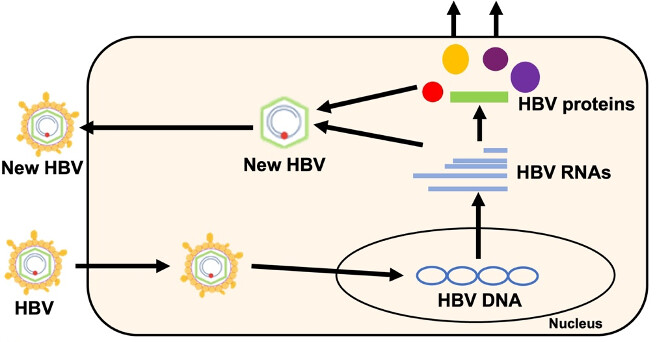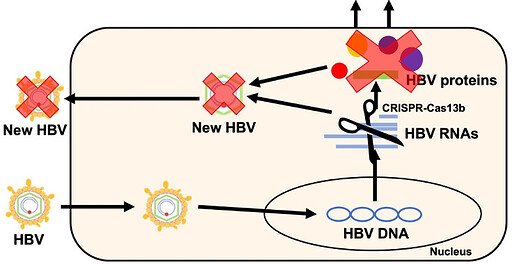Hi everyone! My name is Laura and I am a postdoc in Peter Revill and Margaret Littlejohn’s lab at the Peter Doherty Institute for Infection and Immunity in Melbourne, Australia. My postdoc is focusing on developing a potential new treatment for hepatitis B virus, using a protein called CRISPR-Cas13b.
Hepatitis B virus is a DNA virus, but replicates through RNA. These RNAs code for the HBV proteins and one of the RNAs is also turned back into HBV DNA to make more HBV (Figure 1). High levels of some of the HBV proteins cause the immune system to be exhausted, preventing it from effectively controlling the HBV infection. Some studies have suggested that reducing the HBV proteins, will allow for the immune system to recover and may allow it to clear the virus. The HBV proteins are not targeted by current HBV treatments. As the RNA makes the proteins and is essential for HBV replication, the HBV RNA is a novel target for new treatments.
Figure 1. HBV lifecycle.
HBV enters the cell and the HBV DNA is released into the nucleus of the cell. The HBV DNA makes the HBV RNA. The HBV RNA makes the HBV proteins and one of the HBV RNAs is turned back into DNA to make new HBV that will go on and infect other cells.
The CRISPR-Cas13b protein is like a pair of scissors that is naturally found in bacteria. Bacteria use this protein to target and cut the RNA of invading germs, as a way to protect itself from being infected. Scientists have worked out a way to repurpose the CRISPR-Cas13b protein so it can be used in human cells to target human RNAs or human viruses, such as influenza and SARS-CoV-2. This is achieved by designing a guide sequence, known as a guide RNA, that matches the RNA sequence that we want to target. The guide RNA tells the CRISPR-Cas13b where to cut the RNA. Once the RNA is cut, it can no longer make the proteins that it codes for (Figure 2).
Figure 2. CRISPR-Cas13b mechanism.
RNA is normally turned into protein. The guide RNA tells the CRISPR-Cas13b protein which RNA to bind to. The CRISPR-Cas13b protein then cuts the RNA and therefore, no protein can be produced.
As HBV replicates through RNA, we had the idea that CRISPR-Cas13b could be used to target and cut the HBV RNAs to stop HBV from replicating and stop the production of the HBV proteins (Figure 3). We designed guide RNAs that matched different regions of the HBV RNAs and would match different HBV genotypes. We then tested whether CRISPR-Cas13b could target and reduce HBV proteins and replication in cells in a dish in the laboratory. Excitedly, we found that CRISPR-Cas13b was very effective at reducing the HBV proteins and replication in these cells. We are now testing CRISPR-Cas13b in a HBV mouse model as the next phase of development of this potential therapy. We are so far excited by our findings. We strongly believe that CRISPR-Cas13b has great potential to be a novel therapy for HBV.
Figure 3. Cas13b targeting HBV.
Cas13b targets and cuts the HBV RNAs, preventing the production of the HBV RNAs and preventing new HBV from being produced.


